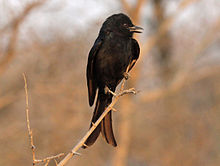- Fork-tailed Drongo
-
Fork-tailed Drongo 
Conservation status Scientific classification Kingdom: Animalia Phylum: Chordata Class: Aves Order: Passeriformes Family: Dicruridae Genus: Dicrurus Species: D. adsimilis Binomial name Dicrurus adsimilis
Bechstein, 1794The Fork-tailed Drongo, Dicrurus adsimilis, also called the Common Drongo, African Drongo or Savanna Drongo, is a drongo, a type of small passerine bird of the Old World tropics. The species was earlier considered to cover Asia, but the Asian species is now called the Black Drongo (Dicrurus macrocercus). They are members of the family Dicruridae.
The Fork-tailed Drongo is a common and widespread resident breeder in Africa south of the Sahara. These insect-eating birds are usually found in open forests or bush. Two to four eggs are laid in a cup nest in a fork high in a tree.
These are aggressive and fearless birds, given their small size, and will attack much larger species, including birds of prey if their nest or young are threatened.
The male is mainly glossy black, although the wings are duller. It is large-headed and has the forked tail which gives the species its name. The female is similar but less glossy. The bill is black and heavy, and the eye is red.
The Fork-tailed Drongo is 25 cm long. It has short legs and sits very upright whilst perched prominently, like a shrike. It flycatches or take prey from the ground and is attracted to bush fires.
The call is a metallic strink-strink.
The subspecies D. a. modestus (Príncipe) together with D. a. coracinus and D. a. atactus (Bioko and mainland west and central Africa from Guinea east to western Kenya and south to Angola) is sometimes split as a separate species, the Príncipe Drongo or Velvet-mantled Drongo D. modestus, (Hartlaub, 1849). Sometimes this species is split further into Príncipe Drongo D. modestus and Velvet-mantled Drongo D. coracinus (including atactus).
References
- BirdLife International (2006). Dicrurus adsimilis. 2006. IUCN Red List of Threatened Species. IUCN 2006. www.iucnredlist.org. Retrieved on 12 May 2006.
- African Bird Club (2006) ABC African Checklist: Passerines. Accessed 16/01/08.
- Birds of The Gambia by Barlow, Wacher and Disley, ISBN 1-873403-32-1
- Sinclair, Ian & Ryan, Peter (2003) Birds of Africa south of the Sahara, Struik, Cape Town.
External links
- fotocommunity.de A very nice photo of a Fork-tailed Drongo
- Fork-tailed Drongo videos, photos & sounds on the Internet Bird Collection
- Photo of a fork tailed drongo taking off from a branch
Gallery
Categories:- IUCN Red List least concern species
- Drongos
Wikimedia Foundation. 2010.



